CBSE Previous Year Question Papers Class 12 Geography 2017 Delhi
Time allowed : 3 hours
Maximum marks: 70
True
- There are 22 questions in all.
- All questions are compulsory.
- Question number 1 to 7 are very short-answer questions carrying 1 mark each. Answer to each of these questions should not exceed 40
- Question numbers 8 to 13 are short-answer questions carrying 3 marks each. Answer to each of these questions should not exceed 80-100 words.
- Question numbers 14 to 20 are long-answer questions carrying 5 marks each. Answer to each of these questions should not exceed 150
- Question numbers 21 to 22 are related to identification or locating and labelling of geographical features on maps, carrying 5 marks each.
- Outline maps of the World and India provided to you must be attached within your answer-book.
- Use of templates or stencils for drawing outline maps is allowed.
True
Question 1.
Which are the two major types of settlements according to their shape found in the world? [ 1/2+ 1/2= 1]
Answer:
Two major types of settlements according to their shape found in the world are:
- Compact settlement and
- Dispersed settlement.
Question 2.
Name the state of India having the least share of population according to the Census 2011. [1]
Answer:
According to census 2011 of all states, having least share of population is “Sikkim”.
Question 3.
What is the mayor function of the National Highways Authority of India? [1]
Answer:
Major function of the ‘National Highway Authority of India (NHAI)’ is operation, maintenance
and development of highway throughout India.
Question 4.
Why does gathering have little chance of becoming important at the global level ? Explain
one reason. [1]
Answer:
In early stage of human civilisation, they were greatly influenced by nature around them and
were living on Gathering. Thus, the primitive man was completely dependent on natural environment.
Question 5.
With the passage of time, human started understanding their environment, hence going back to gathering has very little chance.
Answer:
Differences between “node” and “link” are:
- A “Node” is the meeting point of two or more routes.
- A “Link” is a road that joins that nodes
Question 6.
Classify rainfed farming on the basis of adequency of soil moisture during cropping season.
Rainfed farming is classified to “Dryland Farming” and “Wetland Farming”. Farming in areas with less than 75 cm annual rainfall is known as dry land farming and areas receiving more than 75 cm are called wet land or rainfed agriculture.
Question 7.
‘The Volga is one of the most developed inland water-ways in Russia”. Justify. [1]
Answer:
The Volga Inland waterways of Russia, is very famous waterway because :
- It connects various industrial regions of Russia.
- It connects various navigable canals.
Question 8.
Study the map given below carefully and answer the questions that follow : [1+2=3]
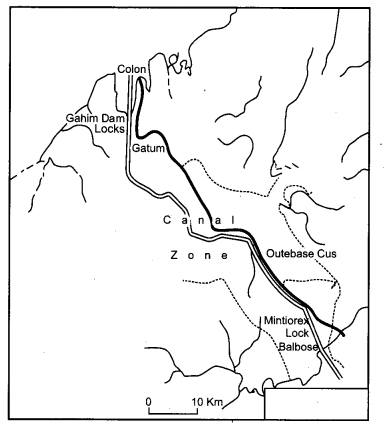
(8.1) Identify and name the canal shown in the map.
(8.2) State any four features of this canal.
Answer:
(8.1) Panama canal is shown in the map.
(8.2) Main features of ‘Panama Canal’ are :
- It connects Adarttic and Pacific oceans.
- Canal is constructed across Panama Isthumus between Republic of Panama and Colon (USA) and its total length is 77 km.
- It involves deep sea cutting.
- It has six locks system.
- It shortened the distance between east and west coast of USA.
Question 9.
Describe any three features of Konkan Railway. [3]
Answer:
Main features of Konkan Railways :
- Construction of Konkan railways is one of the biggest achievements of Indian Railway, as it is built in toughest terrain between Arabian Sea and Western Ghats.
- This line is 760 km long.
- It crosses small and big 146 rivers, 2000 bridges approximately and 91 tunnels on the Ghat Mountains.
- Asia’s largest Rail Tunnel lies in this route.
- It connects Roha in Maharashtra to Mangalore in Karnataka.
Question 10.
Study the given diagram carefully and answer the questions that follows:
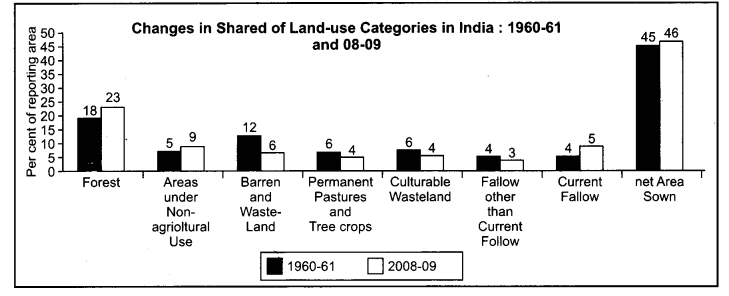
Question 10.1.
Which land use category has shown the highest increasing trend ? What percentage in reporting area has increased in that category, during the given period ?
Answer:
Highest increasing trend is “Areas under non-agricultural use”. This increase in terms of percentage is 5 : 9 or 80%.
Question 10.2.
Explain any two reasong responsible for the increasing trend in that category. [3]
Answer:
Reasons for increase in use of areas under non-agricultural use :
- Changing structure of the Indian economy is increasingly dependent on the industrial and service sector’s contribution for development. To increase it new ventures and industries are built.
- Expansion of industrial and service sector was emphasised upon.
- Expansion of related infrastructural facilities for the development of the area to put it to other use.
- Expansion of area under urban and rural settlements specially in housing sectors also increases the trend.
- It is expanding at the expense of waste lands and agricultural lands.
Question 11.
Explain the three basic differences between rural and urban settlements in India. [3 × 1 = 3]
Answer:
The basic difference between rural and urban settlements in India :
- Rural settlements derive their life support from land based primary activities while urban settlements depend on processing of raw materials and various services.
- Cities act as nodes of economic growth. They provide goods and services to both urban and rural centres.
- Rural settlements supply food and raw materials while urban areas provide services.
- Both settlements differ in social relationship, attitude and outlook.
Question 12.
“Nature and humans are inseparable elements”. Justify the statement with suitable examples. [3 × 1 = 3]
Answer:
Nature and humans are inseparable elements because :
- The earth is the home of mankind. It may be in different forms. All types of life supports are provided by nature. They directly depend on nature.
-
Nature and humans are inseparable and should
be seen holistically. Human beings are directly dependent on nature for various resources which sustain them. , - Physical features are described in metaphors using symbols from the human anatomy. These features include face of earth, nose of glacier, eye of storm, mouth of river, neck of isthmus, profile of soil etc.
Question 13.
“Air pollution is very harmful to flora, fauna and property.” Explain any three values which can help in maintaining pollution free air to some extent. [3 × 1 = 3]
Answer:
Air pollution is very harmful to flora, fauna and property. Flora and fauna are the plants and animal life around us. The main reason behind air pollution is combustion of coal, petrol, diesel, solid waste disposal and industrial wastage. By air pollution, the quantity of oxides of sulphur, Oxides of nitrogen, carbon monoxide, hydrocarbon, ammonia exceeds normal acceptable limits in the air we breathe, thus causing infections and diseases.
We can maintain pollution free air through :
- Air becomes polluted when its normal composition is disturbed either by nature or by man or by both. Since air pollution is harmful for environment and mankind, it is our responsibility to save air from pollution by using less pollutant type elements.
- Awareness about the harmful effects of pollution should be spread everywhere.
- People should feel duty bound to save air.
- People must follow rules for saving air and environment.
- We must use eco friendly non-conventional sources of energy (solar, bio-gas and wind energy) as conventional energy production from source like coal, oil and gas are harmful.
- People should use public transport as far as possible against individual transport (private cars) to avoid air pollution.
Question 14.
Describe the way of life of nomadic herders in the world. [5 × 1 = 5]
Answer:
Way of life of nomadic herders in the world are :
- Animals are the life of herders. They rely on them for everything including food, clothing, shelter, tools and transport.
- They move from one place to another place with their livestock and move in search of two vital necessities, fodder and water.
- They follow well defined, territory. They move according to the season. For example, Lapps of Tundra region migrate towards the North in the summer season and towards Southern coniferous forest belts in winter.
-
Nomadism is associated with these three distinct regions :
- Core region which is from Atlantic shores of North Africa eastward to Arabian Peninsula into Mangolia and Central China.
- Second is Tundra region of Eurasia.
- Third is southern hemisphere south-west Africa to Madagascar.
- In mountainous regions they practice transhumance.
Question 15.
Why do large scale industries choose different locations ? Explain any four factors which influence the industrial location. [1 + 4 = 5]
Answer:
Industries are established for production of various item with a view that they want to earn profit by reducing costs. Therefore, industries are located at points where cost of production is lowest. Factors influencing industrial locations :
- These are established in such area where supply of raw materials is easily available.
- Industries want good market to sell their products. Hence, they choose a place where access of market is available.
- Availability of trouble free labour is another factor for establishment of industry, where labour is easily available at low cost.
- Industries need continuous supply of energy, i. e., electricity, diesel, CNG etc.
- Every industry needs transportation to carry their product from one place to other hence, road/ railway are available at nearnest place.
- Similarly, industry needs trouble free communication services to receive and place various orders.
Question 16.
Explain any five factors responsible for the development of ‘Mumbai-Pune industrial region. ‘ [5]
Answer:
Mumbai-Pune Industrial Region : This region extends from Thane to Pune and in adjoining districts of Nasik and Sholapur. In addition, industries have grown at a rapid pace in Kolaba, Ahmednagar, Satara, Sangli. Major factors responsible for the development of “Mumbai-Pune industrial region.”
- Favourable climatic conditions for the development of cotton textile industry. Since cotton was cultivated in the black soil area of Narmada and Tapi basis.
- Opening of the Suez canal in 1869 providing impetus for its growth.
- Availability of port facility for export-import and communication link with the peninsular hinter land made the Mumbai as Hub of cotton export centre of India.
- The electricity was available as the hydel power was developed in Western Ghats.
- Availability of labour in the region.
- With Mumbai-high petroleum fields, favoured the growth of refineries and petrochemicals.
- Growth and development of various other industries e.g., engineering goods, pharmaceutical and chemical industries, electricals and electronics, software, ship building came up in the region.
Question 17.
“90 percent of the world population lives in about 10 percent of its total land area, whereas remaining 10 percent population resides in the 90 percent of its land area.” Support the statement with suitable examples. [5]
Answer:
90% of the world population lives in about 10% of its total land area, whereas remaining 10% population has spread over 90% of land area. The reasons are:
- Density of population is high in river valleys due to water availability through rivers and canals. The soil and water makes the land usable for agriculture.
- The plains are densely populated while hilly areas and deserts are sparsely populated because of uneven terrain.
- Population also depends on climatic conditions. Hot, cold and dry climates have sparse populations example : Tundra region is very cold all the time, with snow, these are less populated, in deserts due to accute scarcity of water and without agriculture the area remains sparse populated. But areas of moderate climate have dense population.
- Areas such as Gangatic plains, deltas, north Indian plain have higher proposition of population because of fertile soil with possibility of agriculture.
- Development of transport network, industrialisation and urbanisation are some important socio-economic and historical factors which influence the distribution of population.
Question 18.
“An uneven distribution of population suggests a close relationship between population and physical and socio-economic factors.” Support the statement with suitable examples. [5]
Answer:
An uneven distribution of population suggests a close relationship between population and physical and socio- economic factors,
- Physical factors : Among the physical factors, reliefs, climate and availability of water are main factors. Because of these factors northern areas of India have higher density of population than the interior districts of Central India Plateu and southern India.
-
Socio-economic Factors : Evolution of settled agricultural development and agriculture, development of transport network and urbanization are socio-economic factor influencing the distribution of population.
The moderate density of population is seen in Odisha, Assam, Gujarat, Andhra Pradesh, Tamilnadu etc., due to newly developed canal network and possibility of agriculture, industrial development and favourable climate to some extent.
Question 19.
What is human development ? Analyse the four pillars of human development. [1 + 4 = 5]
Answer:
Human development is a process that enlarges people’s choices and improves their life. A meaningful life is not just a long one. It must be a life with some purpose. This means that people must be healthy, be able to develop their talents, participate in society and be free to achieve their goals.
Four pillars of human developments are :
- Equity : Equity means making equal access to opportunities available to everybody. The opportunities available to people must be equal irrespective of their gender, race, income and the caste.
- Sustainability : It refers to continuity in the available opportunities. This means each generation must have same opportunities. Therefore, we must use our environmental, financial and human resources in such a way that our future generations are not deprived of these opportunities.
- Productivity : It means human labour productivity of work. It must be enriched by building capabilities in people. In fact, people of a country are its real wealth.
- Empowerment: It refers to have power to make choices. Such power comes from increasing freedom and capabilities. Good governance and people oriented policies are required to empower people. The empowerment of socially and economically disadvantaged group is of special importance.
Question 20.
“Scarcity of water on account of its increased demand, possesses possibility the greatest demand in India.” Analyse the statement. [5]
Answer:
Increasing demand for water is a challenge of India. The reasons are :
- India has a large population and resources are very limited. Groundwater level is depleting due to excessive take off of water for domestic or agricultural use.
- Rising demand of water for increasing population. Since water is limited and increasing population need water for daily necessities, it is creating problem.
- There is rapid industrial growth and every industry needs water hence demand is increasing.
- More water is required for irrigation to increase
- Urbanisation and modern lifestyle has increased the demand as present days houses are equipped with showers and bathtub. Every house has their own car and they use water to clean/wash their car daily.
- Water pollution has added to water shortage since Indian cities are not having sufficient/proper waste water treatment plant agricultural production as rainfall is highly variable.
Question 21.
Identify the five geographical features shown on the political outline map of the world as A, B, C, D and E and write their correct names on the lines marked near them with the help of following information [5]
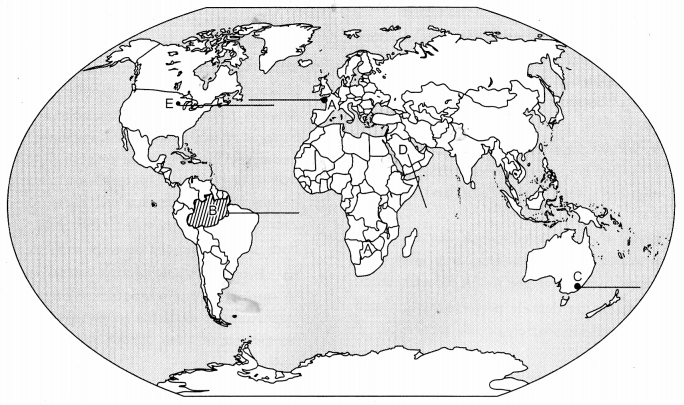
(A) A large country of Europe in area.
(B) An area of subsistence gathering.
(C) The terminal station of a ‘trans-continental railway’.
(D) A major sea-port.
(E) An international airport.
Answer:
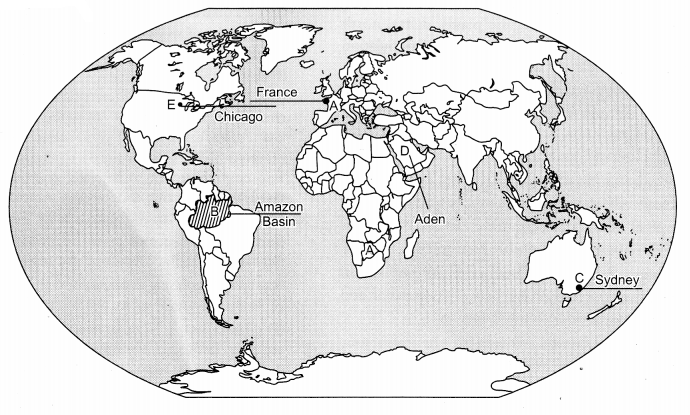
True
False
Question 1.
Which form of rural settlement pattern develops along roads, railway-lines, rivers and canals in the world ? [1]
Answer:
Linear pattern form of rural settlement develops along roads, railway lines, rivers and canals in the world.
Question 2.
Which stream of migration recorded the highest number of migrants at the level of intra-state
migration in India ? [1]
Answer:
The highest number of migrants at the level of intra-state migration in India is ‘Rural to Rural’.
Question 3.
Which is the apex body responsible to improve the quality of roads at national level in India ?
[1]
Answer:
The National Highway Authority of India (NHAI) with its head office in New Delhi, is the apex body for highways.
Question 11.
Distinguish between clustered and semiclustered rural settlements of India, stating three points of distinction. [3]
Answer:
The basic differences between Clustered and Semi-clustered rural settlement of India are : Clustered Rural Settlements :
- The clustered rural settlement is a compact built up area of houses.
- Such type of settlements are found in fertile alluvial plains.
- People live in the compact villages for security or defense reason.
True
- They may result from tendency of clustering in a restricted area of dispersed settlements.
- Such settlements are wide spread in the Gujarat plains and in some parts of Rajasthan.
- One or more sections of society choose to live a little away from the main cluster.
Question 14.
What are the two types of subsistence agriculture practised in different countries, of the world ? Describe the main features of these types. [1 + 4 = 5]
Answer:
Farming is practised in various ways across the world depending upon the geographical condition, demand of produce, labour and level of technology. Farming can be classified into two main types :
(i) Primitive subsistence agriculture and
(ii) Intensive subsistence agriculture.
False
- It is also called shifting agriculture and burn/Jhuming/Milpa/Ladang. ’
- It is widely practised by tribes in Africa, South and Central America, South-east Asia.
- The vegetation are cleared by fire and ashes added to soil fertility. In these areas of heavy rainfall quick regeneration of vegetation takes place.
- After the soil looses its fertility, land is abandoned and cultivator moves to a new plot.
False
- It is practised in densely populated regions of monsoon in Asia.
- Land holdings are small.
- Farmers use simple tools and more labour including whole family members.
- Climate with large number of sunshine days and fertile soil by using farm yard manure permits growing more than one crop annually on the same plot.
- The crops grows in such fields are rice, wheat, maize, pulses and oil seeds.
Question 16.
Explain any five factors responsible for the development of ‘Hugli industrial region’. [5]
Answer:
The development of “Hugli industrial region”, includes areas around river Hugli in West Bengal.
The main reasons of development of this belt:
- This region is spread in narrow belt from Bansbaria and Naihati in North to Birla Nagar in South along Hugli river in 100 km distance.
- The river Hugli offered the best site for the development of Inland river port as nucleus to these industries. It also has better connectivity of roads, railways, seaports and airports.
- Opening of coal field of Damodar valley.
- Number of Jute mills in the proximity from where large quantity of jute products are exported.
- Availability of cheap labour in the surrounding areas.
Question 17.
What is the meaning of density of population ? Examine the four geographical factors that influence the distribution of population in the world with suitable examples. [1 +4 = 5]
Answer:
Meaning of Population Density : The ratio between the number of people to the size of the land/area of state. The number of people inhabiting per unit of land is called population density. As per census 2011′, Bihar is most densely populated state with 1106 persons per square km, followed by West Bengal with 1028 persons. Arunachal Pradesh has least density with only 17 person per sq. km. Geographical factors that influence the populations distribution in the world :
- Relief : Relief is the most important factor influencing and distribution of population. High mountains, rugged terrains and some of plateous restrict human settlement. Many parts of the Himalayas, Rockies and Andes are without any population.
- Climate : Excessive heat, cold, dryness or wetness restrict human population. Hence areas with normal climate are more dense. Apart from human health, climate affects agriculture as adverse weather conditions result in crop failure.
- Soil : Areas of fertile soil permit high concentration of population because it forms the base for high agricultural activities.
- Natural resources : Due to availability of natural resources, industries grow up, hence area becomes populated.
True
False
Question 1.
Write any two features of rectangular rural settlement pattern in the world. [1]
Answer:
The features of rectangular rural settlements pattern are :
- Roads cut each other at right angles.
- They are found in plains and valleys.
Question 2.
Which state of India has the highest percentage of population below poverty line ? [1]
Answer:
Odisha (Orissa) is the state of India which has highest percentage of population below poverty line.
Question 3.
Which type of roads provides maximum links in India ? [1]
Answer:
Rural roads and districts roads provide maximum links in India.
Question 11.
Explain any three points of distinction between ‘Hamleted rural settlements’ and ‘Dispersed
rural settlements’ of India. [3]
Answer:
| Hamleted Rural Settlements | Dispersed Rural Settlements |
| (i) They are fragmented into many units. | They are isolated settlements. |
| (ii) This segmentation is motivated by social and ethnic factors. | Extreme dispersion of settlement is caused by terrain and land resources. |
| (iii) Such settlements are found in Northern plains etc. | Such settlements are found in the Himalayan Mountains and in Kerala etc. |
Question 14.
Describe any five features of plantation agriculture practised in different regions of the world. [5]
Answer:
Main features of plantation agriculture practised in different regions in the world :
-
Plantation agriculture was introduced in the tropical lands by Europeans and North Americans primarily in the colonies ruled by them.
Plantation crops are coffee, tea, banana, sugarcane, pine apples etc. - Estate for plantation are of very large size, sometimes running into the thousands of hectares.
- It requires large capital investments, managerial and technical support and scientific method of cultivation.
- The labour are supplied by local people at cheaper rates while technical and skilled assistance comes from temperate lands.
- Cheap transport is required to link the estates with factories and markets for export of products.
Question 16.
Explain any five factors responsible for the development of ‘Gujarat industrial region. [5]
Answer:
Gujarat Industrial Region: The nucleus of this region lies between Ahmedabad-Vadodara as a result is also known as Ahmedabad-Vadodara industrial region. The main features of growth of this regiori are :
- This region extends upto Valsad and Surat in the south and Jamnagar in the west.
- This region is associated with cotton growing tracts with location of textile industries.
-
With discovery of oil and gas in Gulf of Khambat area led to the establishment of various
oil refineries and petrochemicals around Ankleshwar, Vadodara and Jam Nagar. - Kandla port provides the basic infrastructure for import and exports.
- Developent of other heavy and basic chemicals, dyes, pesticides, engineering machinery, textile machinery, pharmaceuticals and dairy products have developed in this region.
- Surat has best diamond cutting and processing units in the world.
- Due to better roads and highways, transport facilities are available in plenty.
Question 17.
What is age structure ? Interpret with example the triangular shaped age-sex pyramid. [5] Answer:
Age structure is the number of people of different age group.
(i) Generally the population is categorised into three broad age groups :
(a) children,
(b) adults and
(c) aged
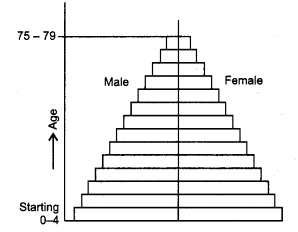
(ii) Most countries of Africa, Asia and Latin America have high birth rate and they have large size population in the lower age group. Countries having low birth rate and high life expectancy have more people in old age groups.
(iii) If we draw a triangular shaped pyramid having wide base and taper top this is a typical diagram to show age and sex structure of populations. The base and apex represent youngest and oldest age groups respectively.
(iv) This triangular pyramid is typical of less developed countries like Nigeria in Africa, Bangladesh in Asia and Mexico in south America.
(v) Wide base means high birth rates.
(vi) Tapered top indicates high death rates.